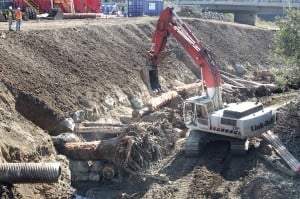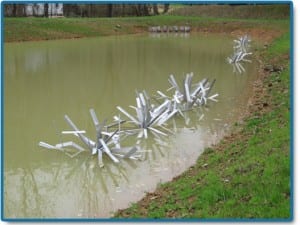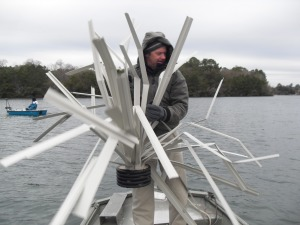Category: Fish Habitat News
If you have questions about natural fish habitat, fish structure, fish attractors, artificial fish habitat or Growing big fish, this is the Structurespot.
Here you will find information about fishiding artificial fish habitat, as well as all the others. From stories about sinking train cars and planes, to planting natural plants, we can talk about it here. Show us your own contraptions and how they are working out. Send us your pics of your structure and get advice on all aspects of this growing industry.
Derelict boats burying prime fish habitat.
Derelict boats that are along the White Salmon River, as well as other garbage, could get stuck at the mouth of the Columbia River, muddying up and burying prime fish habitat.
COLUMBIA RIVER GORGE – The White Salmon River is in for somewhat of an overhaul.
When the Condit Dam is dismantled, Continue reading “Derelict boats burying prime fish habitat.”
Reclaiming trees for fish habitat

Like ostriches with their heads in the sand, tall redwood trees have burrowed into the creek’s north bank, leaving their bushy root balls sticking out in the stream bed.
Never have Napa redwood trees behaved so strangely Continue reading “Reclaiming trees for fish habitat”
Arizona fish habitat video for Apache lake
See what work is being done on a large scale in Arizona in the name of fish habitat.
See the dozens of unique artificial fish habitat models, fish attractors and fish cover used at fishiding.com, the industry leader and only science based, man made and artificial fish habitat, proven to provide all fish with cover they prefer to prosper.
Fish Habitat Project Starts on the Ashtabula River
The Ohio Environmental Protection Agency is coordinating a federal, state and local effort to develop 1,500 feet of fish shelf in the lower two miles of the river, an area best known for its hard-armored and sheet-piled riverbanks. The project will provide northern pike, muskellunge and other native fish species a shallow water habitat necessary for foraging and spawning. “We are nearly tripling the Continue reading “Fish Habitat Project Starts on the Ashtabula River”
Stream restoration hurts fish more than grazing
Some ranchers in eastern Oregon are crying foul over a stream restoration project they believe has caused more harm to threatened fish than cattle grazing. See the dozens of unique artificial fish habitat models, fish attractors and fish cover used at fishiding.com, the industry leader and only science based, man made and artificial fish habitat, proven to provide all fish with cover they prefer to prosper.
“To see the devastation that occurred in the name of fish habitat is just mind-boggling,” Curtis Martin, incoming president of the Oregon Cattlemen’s Association, said.
Ranchers who rely on numerous allotments in the Malheur National Forest for cattle grazing must comply with strict standards to prevent damage to stream banks and fish habitat.
Grazing in the national forest is the subject of litigation by environmental groups, and the practice has long been contentious along Camp Creek, part of the John Day River watershed where the restoration work is taking place.
Ken Holliday, a rancher in the area, said the U.S. Forest Service restoration project has involved heavy machinery tearing out vegetation and moving logs along more than 6 miles of stream.
Compared to such activity, grazing is much less disturbing to the habitat of steelhead and salmon that are federally protected under the Endangered Species Act, Holliday said.
“The double standard between logging, grazing and what they can do is off the chart,” he said. “You can run cows forever and not do what they did.”
Apart from restrictions on grazing cattle in the national forest, regulations often prevent ranchers from conducting similar activities involving heavy equipment within streams on their private land, Holliday said.
“Does anybody see the irony here?” he said.
Martin said ranchers aren’t trying to be abusive of the Forest Service, but the level of disruption to Camp Creek seems bizarre in light of the concerns about impacts to fish from stream bank alteration.
The group plans to file a Freedom of Information Act request to determine what standards the Forest Service had to meet and what environmental analysis the project had undergone, he said.
“We’re trying to get a level playing field where everybody plays by the same rules,” Martin said.
John Gubel, a Forest Service district ranger overseeing the project, said he could see why the project would raise the ire of ranchers.
“I understand their concern because the pressure is on them to meet these standards,” he said.
However, the restoration work is necessary for two reasons, said Gubel.
First of all, Camp Creek and its tributaries contained several elevated culverts that were barriers to fish passage, he said. Those were replaced with “bottomless arches” that allow unimpeded migration.
Secondly, the agency sought to correct previous restoration work that was overseen by Forest Service managers in the 1980s and 1990s, he said. At that time, logs were placed across the stream to create pools for fish.
As the Forest Service monitored the effects of this project, it turned out the “log weirs” had inadvertently led to new problems in the creek, Gubel said.
“They were put in to create pools, but instead they made the stream shallower and wider,” thereby increasing temperatures to the detriment of fish, he said.
The current restoration work sought to remove, cut or reorient those logs to restore a sinuous “snakelike” movement to the creek, he said.
Heavy machinery was used from mid-July to mid-August, a time when such activity is less damaging to fish, and now the agency plans to re-vegetate the affected areas, Gubel said.
The culvert replacement cost about $345,000 and the weir alteration cost about $70,000 to $100,000, paid for with funding from the Forest Service, the Ecotrust nonprofit group and the Confederated Tribes of the Warm Springs Reservation, he said.
The project will work to boost fish populations, which would allow for continued or elevated grazing over the long term, he said.
The impacts on habitat will only be for the short term, since such activities only rarely occur within the stream, Gubel said.By MATEUSZ PERKOWSKI
“The last time we messed around in the creek was 20 to 30 years ago.”
Missouri Department of Conservation Fish study could help future anglers

Francis Skalicky, Missouri Department of Conservation
Fish gotta’ swim…
Long before that became a memorable song lyric in the popular musical “Showboat,” it was a well-known fundamental of a fish’s life cycle. Continue reading “Missouri Department of Conservation Fish study could help future anglers”
Scientists Monitor Caney Fork Fish Habitat
A group of fisheries scientists from Tennessee Tech University are busy monitoring the health of the Caney Fork River by pumping electricity into the water.
Though water and electricity are not usually a good mix, the combination is one of the best methods for collecting fish and determining their health Continue reading “Scientists Monitor Caney Fork Fish Habitat”
Oregon Governor’s Fund Awards More Than $480,000 For 2012 Restoration Projects
Oregon Governor’s Fund for the Environment Awards More Than $480,000 in Grants, Announces New Grants Available For 2012 Restoration Projects
PORTLAND, Ore. – On Thursday, August 25th in Portland, Oregon, Governor John Kitzhaber will award $481,690 in thirteen grants to aid farmers, landowners, and local governments for being stewards of our natural resources.
The grants are funded by the Oregon Governor’s Fund for the Environment Continue reading “Oregon Governor’s Fund Awards More Than $480,000 For 2012 Restoration Projects”
River Maine is getting a makeover under The Environmental River Enhancement Programme

As a boy, I often listened to old anglers’ stories about the might of the River Maine and its yield of catches before my time.
They’d tell of how it used to burst its banks and flood half the town and how salmon used to go tearing upstream Continue reading “River Maine is getting a makeover under The Environmental River Enhancement Programme”



